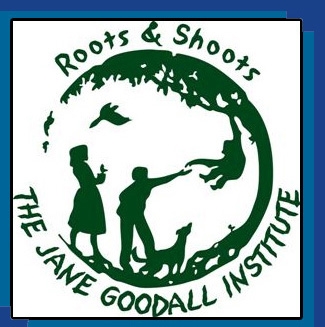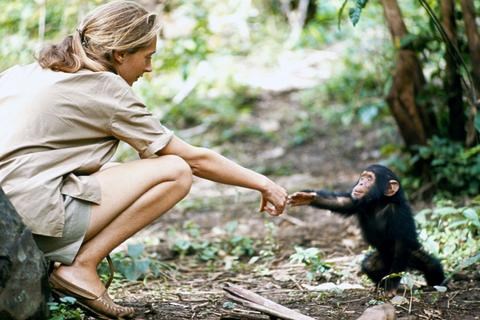A young girl crouches in a chicken coop waiting and watching to see how eggs
are laid. She sits for hours, and after watching a chicken lay an egg, runs
back to her fretful parents. That young girl grew up to be one of the most well
known primatologists in the world, Jane Goodall. Jane was born on April 3, 1934
in London, England. She grew up on the southern coast of England and often
perused Dr. Dolittle and Tarzan. She dreamed of going off to live
in Africa. In 1957 she got her chance to work in Kenya as the assistant to the
well-known paleontologist and anthropologist, Louis Leakey (1903-1972). Three
years later, Goodall got the chance of a lifetime; working and living in
Tanzania with wild chimpanzees. Her life would change forever when she went to
live in Gombe animal preserve to record the animals' behavior and interactions.
Jane Goodall became a true scientific hero because she spent countless years patiently
watching the chimps with an open mind and a strong passion for the chimpanzees
and their environment; a topic she still fights for today.
 |
| Jane Goodall while observing the chimpanzees |
Goodall's patience is
one of her heroic traits. When Goodall first began her studies the chimps were
wary of her: " In the beginning, the chimpanzees were afraid of the young
woman who silently and patiently watched them. It took nearly six months for
the chimpanzees to accept her presence, allowing Goodall to follow them on
their daily travels through the forest" ("Jane Goodall" Animal
Sciences). Goodall knew to study animals in the wild; the animals had to have a
certain level of trust with the scientist studying them. She decided that every
day, armed with bananas she would go to a certain location where the chimps
were. This is where her heroic patience came in handy. All was well for
Goodall, who anticipated more to come: " The chimps soon tolerated her
presence and, within a year, allowed her to move as close as thirty feet to
their feeding area. After two years of seeing her every day, they showed no
fear and often came to her in search of bananas" ("Jane Goodall"
World of Biology). The chimpanzees' relationship with Goodall started off
merely in search of food, but quickly became true friendship. Goodall became so
close to the chimps, that she named each one. Some chimps are called Titan,
Kauka and Mbebo. Goodall was stoical when given the task to observe chimpanzees
in their natural habitat.
 |
| Jane Goodall hugging a chimpanzee |
Jane was also open-minded with her observation
of the wild chimpanzees. Considering that no other scientist before had the
pleasure and patience to become close to the animals "almost nothing was
known about chimpanzees until Goodall conducted her field studies in East
Africa" ("Jane Goodall" Animal Sciences). Jane was excited to
watch and observe these animals because nothing was known about the chimps,
except that we share 99% of our DNA. She also was thrilled that she was the
first to study and learn something from the magnificent animals. Goodall
disproved all scientific theories that humans were the only animals capable of
speech and the use of tools: "By remaining in almost constant contact with
the chimps, she discovered a number of previously unobserved behaviors. She
noted that chimps have a complex social system, complete with ritualized
behaviors and primitive but discernible communication methods, including a
primitive 'language' system containing more than twenty individual sounds"
("Jane of the Jungle"). Goodall, by keeping an open mind that
chimpanzees can do anything, discovered that they have communication methods,
and she understands some of the chimps' language, by listening and using
context clues. Jane also observed Gombe's chimps using strips of grass to pry
bugs out of logs to eat. Because she did not hold tightly to any particular
theories about chimpanzee behavior, Goodall was able to discover many things
about chimpanzees that were previously unknown.
 |
| Roots and Shoots/JGI |
Besides
being patient and open minded, Goodall has an intense passion for protecting
the wildlife and environment. After spending a few years getting her college
degree in England, Goodall returned to Tanzania: "She promptly returned to
Tanzania to continue her field studies and establish the Gombe Stream Research Centre.
Research at this facility is still being conducted to this day, mostly by
Tanzanians" ("Jane Goodall" Animals Sciences). By giving
Tanzanians jobs, she helped boost an economy and encouraged Tanzanian children
to stay in school. Both factors are beneficial in a third world country. Once
the Centre was set up and running, Goodall noticed that the western world was
unaware of happenings to chimps in Africa and in zoos around the world:
"It is easy to be overwhelmed by feelings of hopelessness as we look
around the world. We are losing species at a terrible rate, the balance of
nature is disturbed, and we are destroying our beautiful planet."
("Jane's Reasons for Hope") The Jane Goodall Institute was founded on
the basis of educating about chimps and to be eco friendly, and to live the
life one imagines.They offer programs to make the world a little cleaner, and
give facts about the work of Jane Goodall. Starting April 20th 2012, a movie called Chimpanzee and of all the tickets sold
in opening week, a portion of the proceeds will go to JGI. Goodall did many
things, all for the passion and love she feels toward the chimps with whom she
has spent so many years.
 |
| a young Jane Goodall with a baby chimpanzee |
Jane Goodall has
patience with observing creatures open-mindedly, and is passionate about the
treatment and wellbeing of chimpanzees whether they be wild or in captivity.
Jane is not an inspiration because she is just a scientist, she is an
inspiration because she had a passion for animals, and followed her dream to
change the world. Goodall is an inspiration because she shows that with a
little patience, hard work can pay off. She also inspires because as the world
begins to worry about our depletion of natural resources, Goodall believes that the goodness is contained
in the human spirit and if we work together, humans can do anything.
Works Cited
Goodall, Jane. "Jane's Reasons for
Hope." The Jane Goodall Institute |. Web. 28 Mar.
2012.
"Jane Goodall." Animal
Sciences. Ed. Allan B. Cobb. New York: Macmillan Reference
USA,
2002.
Gale Biography In Context. Web. 25 Mar. 2012.
"Jane Goodall." World
of Biology. Gale, 2006. Gale Biography In Context. Web. 25 Mar.
2012.
Schleier, Curt. "Jane of The
Jungle" Biography 4.5 (2000): 88. Biography Reference
Center.
Web.
27 Mar. 2012
Page created on 4/20/2012 12:00:00 AM
Last edited 4/20/2012 12:00:00 AM
